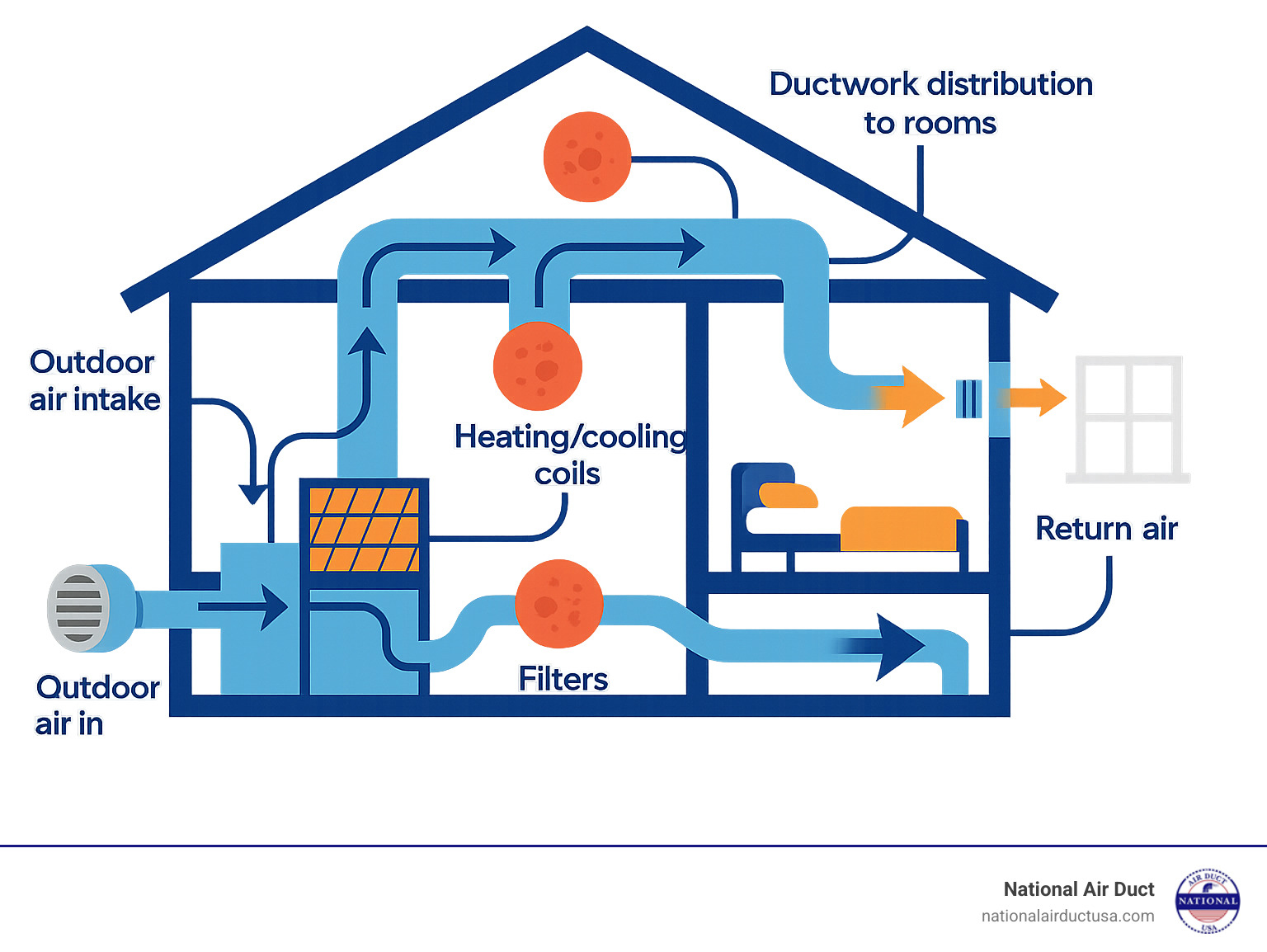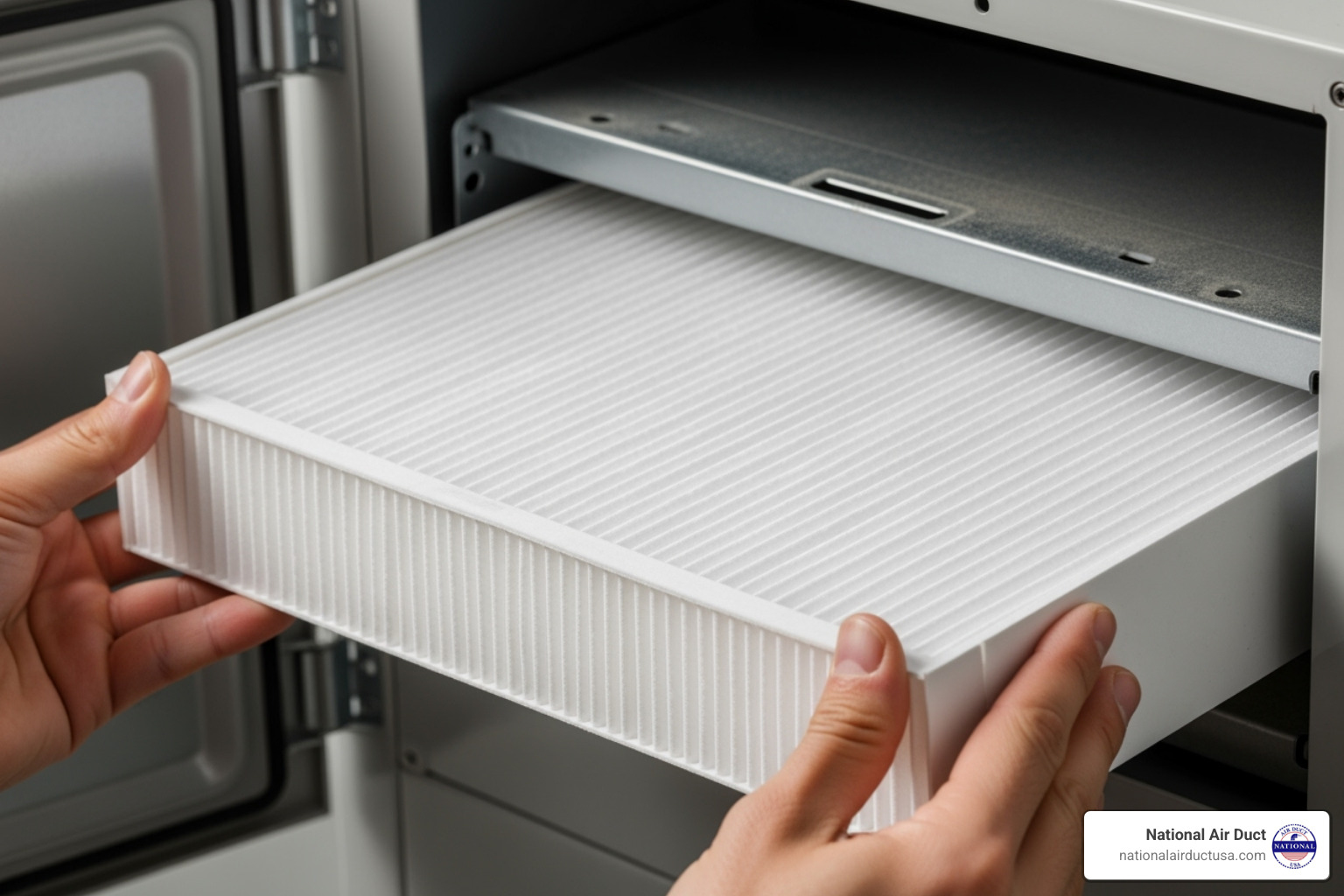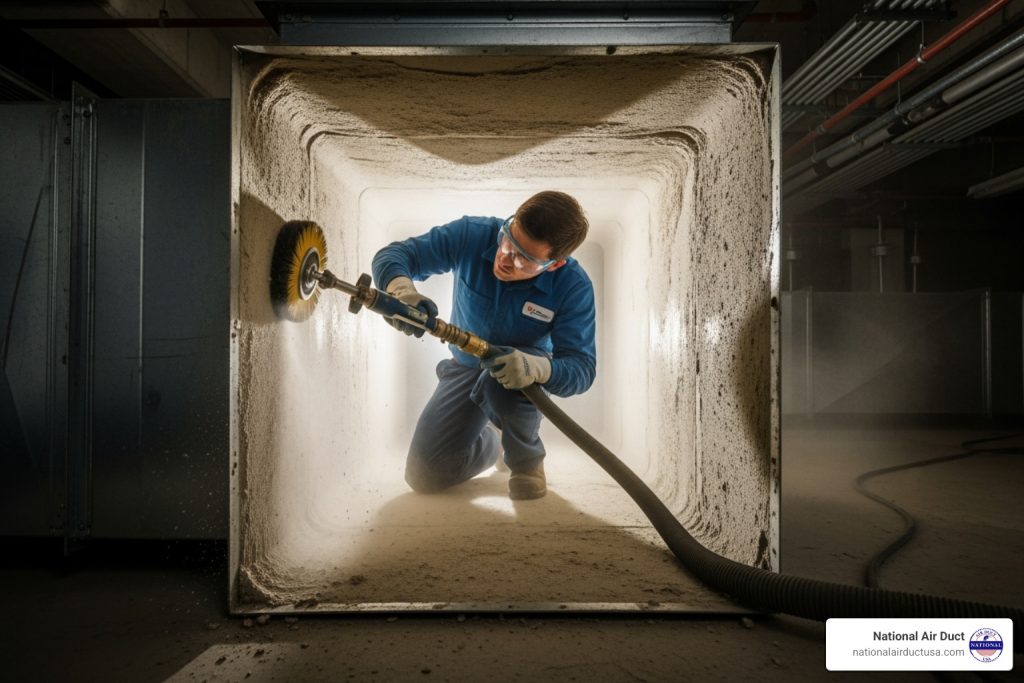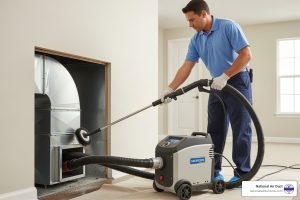The Question Every Homeowner Is Asking About HVAC Safety
Can you spray disinfectant in air ducts? The short answer is: not with just any product, and definitely not as a DIY solution. Here’s what you need to know immediately:
Quick Answer:
- General household disinfectants (like Lysol) should never be sprayed in air ducts
- Only EPA-registered products specifically labeled for HVAC systems can be used
- Professional application is required – this isn’t a DIY job
- Physical cleaning must come first – chemicals can’t replace proper duct cleaning
- Many companies legally cannot claim to “disinfect” ductwork in the US
If you’ve been wondering whether spraying disinfectant in your home’s air ducts is safe or effective, you’re not alone. As one industry expert put it: “As we continue living with the COVID-19 pandemic, more and more duct cleaners are fielding calls about sanitizing and disinfecting ductwork.”
The truth is more complex than a simple yes or no. While your instinct to want cleaner air for your family is absolutely right, the path to healthier indoor air isn’t found in a spray bottle.
The National Air Duct Cleaners Association (NADCA) has been clear: “Source removal of contaminants is still the best method for cleaning and decontaminating HVAC systems.” But what does that mean for you as a homeowner? And when – if ever – might chemical treatments be appropriate?
Let’s clear the air on this confusing topic once and for all.

The Hard Truth: Why You Can’t Just Spray Any Disinfectant in Your Air Ducts
We get it. The idea of germs, mold, or viruses in your air ducts can make you want to grab a disinfectant spray. But spraying household disinfectant into your vents is ineffective, dangerous, and often illegal.
The biggest reason to avoid DIY spraying is safety. Common household disinfectants like Lysol contain ethanol alcohol. Misting this into your HVAC system near an electric motor creates a serious flash explosion risk. This could damage your ductwork or even start a fire.
Beyond the fire risk, chemical fumes can linger, causing respiratory irritation, headaches, or worse, especially for those with allergies, asthma, or chemical sensitivities. Even with professional applications, occupants often need to leave the house for several hours (typically 2 to 8) to allow fumes to clear.
Furthermore, spraying products like Lysol into ducts to kill airborne mold is ineffective. These products are designed for surfaces, not the air. They may mask odors, but they don’t actually disinfect anything in this context.
What the EPA Says About Chemicals in Your Vents
The Environmental Protection Agency (EPA) is clear: general-purpose disinfectants meant for “hard, non-porous surfaces” are not approved for use inside air ducts. Using them this way is a violation of federal law under the Federal Insecticide, Fungicide, and Rodenticide Act (FIFRA).
Why are the guidelines so strict? The EPA has several concerns:
- Unassessed Health Risks: Products not specifically approved for HVAC&R systems haven’t been tested for their effects on occupants when applied inside ductwork. The application method and enclosed space create different exposure risks than wiping a counter.
- Lack of Efficacy Data: There’s often no proof these products work inside HVAC systems, where conditions like airflow, temperature, and humidity are vastly different from a typical hard surface.
- Misleading Claims: Some companies make false claims about products that aren’t registered for specific use in ductwork.
- Legal Violations: Using any antimicrobial product in a way that violates its EPA-approved label is illegal. The EPA has not registered any products that can make disinfectant claims for the ductwork itself.
Only use products specifically approved for the unique environment of your air ducts, and only when applied by trained professionals.
Sanitizer vs. Disinfectant: A Critical Distinction
The difference between a “sanitizer” and a “disinfectant” is a critical, legal distinction defined by the EPA.
- A sanitizer is an EPA-registered product that reduces bacteria to acceptable levels. It typically kills 99.9% of bacteria on a surface.
- A disinfectant is an EPA-registered product that destroys or irreversibly inactivates specific harmful microorganisms like fungi and viruses on hard, inanimate surfaces.
Here’s the key point: while some products are registered by the EPA as sanitizers for use on certain HVAC components (like coils or drain pans), the EPA has not registered any products that can be applied to HVAC systems and make disinfectant claims for the ductwork itself. This means no one can legally claim to “disinfect” your air ducts.
This distinction is crucial. When we discuss can you spray disinfectant in air ducts, we’re usually referring to EPA-approved sanitizers for specific HVAC components, applied under controlled, professional conditions.
So, Can You Spray Disinfectant in Air Ducts Under Any Circumstances?

So, can you spray disinfectant in air ducts? It’s not a regular DIY task. However, professionals can use specific EPA-approved sanitizers in certain situations.
These treatments involve EPA-registered sanitizers applied by a trained pro using special fogging equipment. This precise method ensures even coverage inside already cleaned ductwork for safety and effectiveness.
The Professional Approach: When is it appropriate to spray disinfectant in air ducts?
You wouldn’t spray disinfectant on a dirty counter; you’d clean it first. The same applies to your air ducts. At National Air Duct USA, we only recommend a sanitizer for confirmed mold or bacterial growth, and always after a thorough physical cleaning. It’s not a routine service or a magic fix.
Sanitizing is only recommended for confirmed microbial growth after it has been physically removed. It helps prevent regrowth but is not needed for a standard cleaning where there’s no proof of a germ problem.
Here’s the professional process:
-
First, the Deep Clean: This is the most important step. Our team uses powerful truck-mounted vacuums (up to 12,000 CFMs) and agitation tools (like air whips at 250 PSI) to physically remove all contaminants from your ducts.
-
Confirming the Problem: After cleaning, if we find clear evidence of a mold or major bacterial issue (e.g., from water damage), we might suggest an EPA-registered sanitizer approved for HVAC systems.
-
Expert Application: The sanitizer is applied using a fogging method to evenly coat the inside of the clean ducts. We may briefly turn on your system to help circulate it.
-
Safety First for You: If we use these treatments, we’ll advise that occupants leave the house for 2 to 8 hours to allow any vapors to clear. Your family’s safety is our top priority.
When applied correctly by pros to a clean surface, EPA-registered products are effective. For example, some products kill 99.9% of bacteria, while others like Sporocidin can kill specific viruses and fungi. However, they only work on the germs they are designed for.
Types of Approved Sanitizers
Not all products are created equal. Few are approved for direct application inside ducts, but some EPA-registered sanitizers can be used on HVAC components or duct surfaces after cleaning.
What types of these special products are used in air ducts?
- Botanical Sanitizers: Some professionals use plant-based products with thymol (from thyme), like Benefect’s Decon 30. It kills 99.9% of germs and has a low EPA toxicity rating. Bio-Fresh is another EPA-registered option often used in hospitals.
- Chemical-Based Sanitizers: Other sanitizers use ingredients like Phenol and Sodium Phenate (in Sporocidin) or quaternary ammonium compounds (“Quats”). These are stronger and require careful handling by trained professionals.
- Always Check the SDS! Always ask for the product’s name and its Safety Data Sheet (SDS). This document details the product’s ingredients, safe usage, and intended purpose.
Ensure any product used is EPA-registered for use in HVAC systems and that the professional follows all label instructions. For more info from the EPA, you can check their website: What the EPA says about having air ducts cleaned.
The Real Goal: Source Removal, Not Chemical Cover-ups

To truly improve your home’s air, our main goal at National Air Duct USA is “source removal.” This means physically removing contaminants like dust and debris from your air ducts, not just covering them up with chemicals.
Think of it like a dusty bookshelf: you’d wipe the dust away, not just spray it with air freshener. The same principle applies to your air ducts. Our job is to eliminate the actual problems.
Our team uses powerful, truck-mounted vacuums with up to 12,000 CFMs of suction, paired with special agitation tools. This combination loosens and extracts dust, pet dander, allergens, and other pollutants from deep inside your ductwork, ensuring they are truly gone. You can find more about our process on our website: More info about Residential Air Duct Cleaning services.
Why Cleaning Before You spray disinfectant in air ducts is Non-Negotiable
It’s critical to clean ducts physically before applying any chemicals. Spraying disinfectant on dirty ducts is ineffective and can even make things worse.
Here’s why:
- It’s Ineffective: Chemicals can’t penetrate layers of dust and grime to reach the surfaces beneath.
- Sticky Mess: Spraying liquid onto debris can create a sticky residue that traps even more contaminants, worsening your air quality.
- Allergies Still Happen: Even “killed” mold spores can still trigger allergic reactions. The primary benefit of killing mold is to stop its growth, not to eliminate allergens completely.
A proper physical cleaning is the best way to improve your indoor air quality. Our main goal is to give you a truly Clean Ventilation System, free from the actual dirt and allergens.
How Long Do the Effects Last?
It’s important to have realistic expectations about how long chemical treatments last. While some products like Bio-Fresh claim effectiveness for up to six months, these are temporary solutions. The immediate action of a product like Benefect’s Decon 30 doesn’t guarantee long-term protection.
Chemical treatments offer a short-term fix. As your HVAC system runs, new dust and particles will re-enter the ductwork. Sanitizing can be a helpful extra step in specific cases, but it doesn’t replace regular maintenance, good air filters, and thorough physical duct cleaning. The effects are not permanent.
Smarter Alternatives for Cleaner, Healthier Air

Instead of relying solely on chemical sprays, we advocate for proactive, long-term solutions that genuinely improve your indoor air quality. These alternatives focus on preventing contaminant buildup and continuously cleaning the air that circulates through your home.
Here’s a list of non-chemical ways to improve home air quality:
- Regularly clean and maintain your HVAC system, including outdoor units and coils.
- Change HVAC filters frequently (every 1-3 months).
- Control humidity levels (ideally between 40-60%) to inhibit mold and germ growth.
- Ensure proper ventilation in kitchens and bathrooms.
- Vacuum and dust regularly with a HEPA-filtered vacuum.
- Consider air purifiers for individual rooms.
- Address water damage immediately to prevent mold.
These alternatives are often more effective and safer than relying on chemical sprays in your ducts. They address the root causes of poor indoor air quality, rather than just attempting to treat symptoms.
High-Efficiency Air Filtration
One of the most impactful ways to improve your indoor air quality is through your HVAC system’s air filters. We often find that indoor air pollutants can be 2 to 5 times higher than outdoor levels, and sometimes even exceed 100 times, making robust filtration crucial.
- Standard Filters vs. HEPA Filters: Most standard disposable filters (often MERV 1-4) are designed to protect your HVAC equipment from larger dust particles, not necessarily to significantly improve indoor air quality. High-efficiency filters, particularly HEPA (High-Efficiency Particulate Air) filters, are designed to capture much smaller particles.
- MERV Ratings Explained: MERV (Minimum Efficiency Reporting Value) ratings indicate a filter’s ability to capture airborne particles between 0.3 and 10 microns. The higher the MERV rating, the more efficiently the filter removes particles. While true HEPA filters (MERV 17-20) are generally too restrictive for residential HVAC systems, filters with MERV ratings between 8 and 13 can offer a good balance of air cleaning and system compatibility.
- Benefits: Upgrading your filtration can significantly reduce allergens, dust, pet dander, mold spores, and even some bacteria and viruses circulating in your home’s air. It’s a continuous, passive way to clean your air without chemicals.
In-Duct UV Light Purification
Another excellent chemical-free alternative is the installation of germicidal UV-C lights within your HVAC system. This technology has been used in hospitals and commercial settings for decades and is increasingly popular in residential applications.
- How it Works: UV-C light targets and inactivates airborne microorganisms (mold, bacteria, viruses) as they pass through your ductwork or grow on your HVAC coils. When strategically placed, UV lights can continuously sanitize your evaporator coil, preventing mold and bacterial growth, which are common sources of musty odors and airborne contaminants.
- Benefits: UV light purification offers continuous, chemical-free air sanitization. It’s particularly effective at preventing microbial growth on damp coils and can reduce the spread of airborne pathogens throughout your home. It’s a proactive measure that works quietly in the background.
We offer professional UV Lights Installation services to help you achieve a healthier indoor environment without the concerns associated with chemical sprays.
Finding a Pro You Can Trust: How to Avoid Duct Cleaning Scams
Unfortunately, the air duct cleaning industry has its share of scams. Some companies use foggers and make false promises about “disinfecting” your system for high prices. This means homeowners must be careful and well-informed.
How can you spot a trustworthy service? It comes down to homework and understanding what makes a company reliable. Look for transparency, proper methods, and ethical practices. A good company will focus on source removal – actually cleaning the dirt out – rather than just trying to cover things up with chemicals. They’ll also be upfront about pricing, avoiding “bait-and-switch” tactics.
Questions to Ask Your Duct Cleaning Company
When seeking professional air duct cleaning, asking the right questions is your best defense against scams. Here are key questions to ask potential HVAC cleaning companies:
First off, ask, “Are you NADCA certified?” This is a huge one! NADCA (National Air Duct Cleaners Association) sets the gold standard for HVAC cleaning. Companies certified by NADCA follow strict rules and best practices. We at National Air Duct USA are proud to be NADCA-certified for our air duct and dryer vent cleaning services.
Next, you’ll want to know, “What cleaning method do you use?” A reputable company will always talk about physically removing contaminants using powerful vacuums and agitation tools. Be wary of anyone who only offers “fogging” or chemical sprays without a thorough physical cleaning first.
Always insist, “Can you provide a written quote?” Before any work starts, get a detailed, written quote showing the scope of work and total cost. If a quote seems too good to be true (like $100 for your whole house), it probably is.
If chemical treatments are mentioned, ask, “What chemicals do you use and are they EPA-registered for HVAC systems?” A trustworthy company will be transparent about the product name, its EPA registration number, and provide the Safety Data Sheet (SDS). The EPA hasn’t registered any products that can make disinfectant claims for the ductwork itself, so if a company claims they can you spray disinfectant in air ducts to “disinfect” them, that’s a red flag.
Another good question is, “How long will the service take?” A proper duct cleaning for a typical home usually takes about 2-3 hours. If a company claims they can do it in 30 minutes, they’re cutting corners.
You should also confirm, “Do you have insurance and liability coverage?” This protects you in case of any accidents or damage.
And finally, ask, “Do you emphasize source removal over chemical treatments?” A professional company will always prioritize physically removing contaminants. Chemical treatments should only be a specific, optional step for confirmed issues, never the main solution.
Breathe Easier with the Right Approach
So, we’ve taken a deep dive into the question of can you spray disinfectant in air ducts. What’s the big takeaway from all this? It’s simple: physical cleaning is always the most important step. While a quick spray might sound appealing, it’s often not effective, can be dangerous, and might not even be allowed by law.
Think of chemical treatments, like those EPA-registered sanitizers, as very specific tools. They’re not a general solution for everything. They should only ever be used by a professional, and only after your ducts have been thoroughly cleaned. Even then, they’re typically for specific situations, like confirmed mold or bacteria.
And remember, their effects are temporary. We’re talking around six months. After that, your ducts can start collecting new contaminants. It’s not a “set it and forget it” solution.
At National Air Duct USA, your family’s health and safety are our top priority. We believe in solutions that truly make your indoor air better for the long haul. This means we focus on getting rid of contaminants at the source. We also highly recommend strong air filtration and advanced options like UV light purification.
We always follow strict EPA guidelines and NADCA standards. This ensures that every service we provide is effective, safe, and completely transparent.
For a thorough check-up and professional cleaning or sanitizing services, trust the experts at National Air Duct USA. We’re here to make sure your home’s air is as clean as possible. We’re committed to improving your indoor air quality, making your home more energy-efficient, and even preventing fires. We offer professional, complete, and affordable solutions for homes in Westbury, NY, New York, and the surrounding areas.
Ready to breathe easier? Learn more about our Disinfecting Air Duct services.



